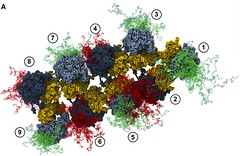Here are some raw notes and thoughts along the way to an article I'm writing for a Michigan publication about Gov. Jennifer Granholm's push for a lithium-ion battery infrastructure to save my state from ruin. I'm skeptical.
What prompted this rant was a piece an editor sent me written by Granholm in the Huffington Post: Michigan Will Lead The Green Industrial Revolution. Granholm writes:
In Michigan, we're not only redesigning the current generation of vehicles to be more fuel efficient, but as the world's epicenter for automotive research and design, we're literally redesigning the entire notion of the automobile. More here
Well, up in Mackinac, Granholm finally acknowledged the obvious -- that Asia is ahead of us. Nathan Bomey of Michigan Biz Review quotes her as saying
"This battery realm is so natural for us because there is right now in
the United States no mass production of batteries, especially for
vehicles, to speak of. That battery production is happening in Asia.
So what we want to do is be the domestic place where batteries are
produced." More here.
Being "the domestic place where batteries are produced" is a fine goal, but a far cry from the delusions of grandeur she pushed for Michigan in that Huffpost piece, which was a combination of jingoistic cheerleading, some fact, some fiction and a whole lotta hope.
Here are a few points to be made, in no particular order. (The only nanotech connection here is that it involves innovation and new technology in general)
1. The Obama Administration and Gov. Granholm have decided, for
various reasons -- some pragmatic, some political, some ideological --
that government is going to build a whole lot of incentives for a
li-ion battery infrastructure for electric vehicles ... one that Japan
and Korea have already built. So, the U.S. is focusing very inward --
short term creation of business, jobs (nowhere near enough to replace
the manufacturing jobs that have been lost) and a U.S. auto industry
that "appears" to be remaking itself.
2. Companies like Sakti3 in Ann Arbor are living off of venture
capital funding but are eager for government funding in order to
survive. They will develop their technology in the direction
government wants them to go. If Obama decided that stimulus money
would go toward urine-powered engines, we'd have a whole lot of
piss-fuel companies starting up and claiming they are the future of
the auto industry.
3. Government is going whole-hog behind one technology because it is
perceived to be closer to market. However, real innovation happens
when you hedge bets and try different technologies. Corn growers
learned that lesson the hard way, when they had no place to sell their
crop after ethanol producers went back on their deals.
4. What does Toyota and VW know that the U.S. auto industry does not?
History says they probably know a great deal. Both of them are pushing
full-force into hydrogen fuel cell technology. Toyota, especially, has
always viewed hybrid electric and electric vehicles as transition
technologies on the way to fuel cells. In Japan, fuel cells for home
use are gaining in popularity -- getting the public used to the idea.
5. To see how a state government can create incentives to speed
development of technology, look at California, where its Zero Emission
Vehicle mandate convinced Toyota to move up the release of its
hydrogen fuel cell vehicle from 2015 to 2014. Remember, it was not too
long ago that the former Big 3 were whining about California's strict
emissions standards. Now, there's no whining anymore.
6. Bottom line is that Michigan lost its status as a center for
automotive innovation a long time ago. So, look at the two traditional
centers of innovation: Japan and California. Both are creating
companies, coalitions and government incentives that lean toward an
automotive future that views battery electric vehicles as a step along
the way toward a completely new hydrogen fuel cell infrastructure.
Granholm is correct in her determination to try to make Michigan a
leader in "something," so, why not compete with Ohio and Indiana to
become a leader in li-ion battery manufacturing -- a U.S. leader,
still behind Japan and Korea? But does that make Michigan again an
innovation leader? Absolutely not. The innovators are still tinkering
away, with or without government incentive and funding.
7. Li-ion batteries may not represent the future of the auto industry,
and hydrogen fuel cells may not, either. It could be that, someday, to
"buy American" means to buy electric, while those interested in buying
something truly innovative and less polluting will buy foreign. Sounds
very much like status quo to me.
Again, these are raw notes, so please tell me where I am right and/or wrong. I won't cry about it ... much.
Backgrounder
Will batteries recharge Michigan’s economy?
Blogging for Center for Independent Media
U.S., at last, begins assault on batteries









